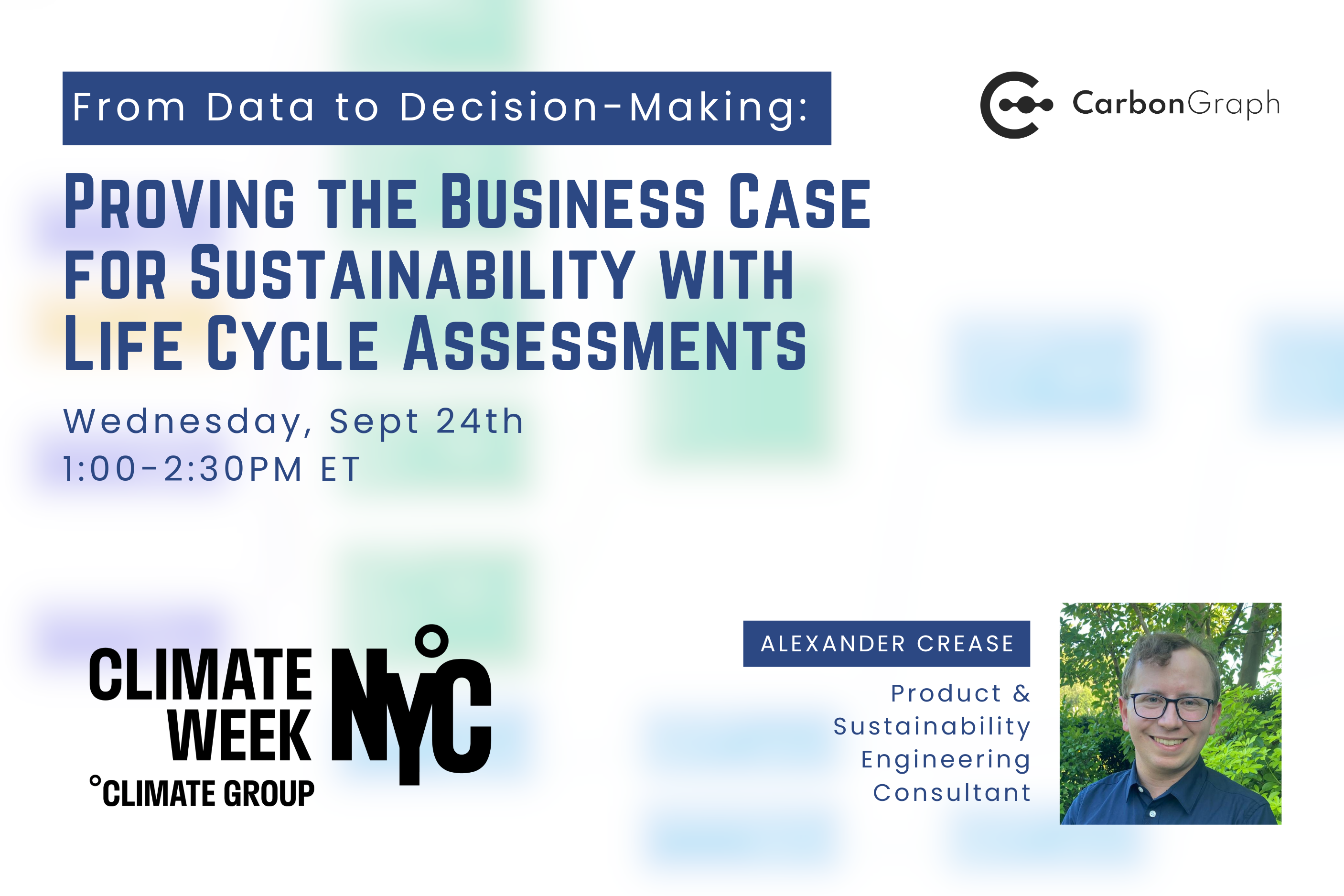
Prove It: How LCAs Turn Sustainability Into a Business Advantage
It’s easy to say your product is sustainable.
It’s much more powerful to prove it with data, and a robust business case.
That’s exactly what we explored in our recent Climate Week NYC webinar:“From Data to Decision-Making: Proving the Business Case for Sustainability with Life Cycle Assessments.”
👉 Sign up and watch the free recording here.
In a fast-paced, hands-on session, I had the opportunity at Climate Week NYC 2025 to guide product designers, sustainability professionals, and business leaders through the practical steps of using Life Cycle Assessments (LCAs) to make better decisions for both the environment and for businesses.
Here’s a quick recap of what we covered, and why it matters.
Why Proving Sustainability Matters
Every sustainability claim is a business decision in disguise.
- Lower carbon emissions? That’s risk mitigation and customer value.
- Energy efficiency? That’s a direct cost saver.
- Increased recycled content? That’s differentiation in the eyes of ESG-conscious buyers. AND often a cost saver too.
- Circularity Strategy? That reduces your manufacturing expenses.
But without credible, science-backed data to support these claims, they often fall flat. That’s where LCAs come in: providing a structured, standardized way to quantify environmental impacts across a product’s entire life cycle, from raw materials to end-of-life.
LCAs as a Strategic Decision-Making Tool
In the webinar, I walked through three real-world case studies. The first, a simple toothbrush. The second, a commercial building system. Finally, we review a consumer electronics product. In both cases, we show how LCAs can uncover not just environmental hotspots, but business opportunities.
I used CarbonGraph to:
- Map environmental and financial data side-by-side
- Model different product scenarios and tradeoffs
- Design carbon reduction roadmaps that actually save money
For example:
- Redesigning a plastics product to use polypropylene instead of ABS reduced emissions and material costs.
- Switching a building from grid electricity to solar power slashed operating carbon impact by over 70%, while offering potential long-term savings through incentives and lower tenant energy bills.
- Upgrading from fluorescent to LED lighting cut emissions and operating costs for both building owners and tenants.
In every case, the LCA model helped participants answer three essential questions:
- What sustainability advantage do we want to prove?
- What baseline model do we need to build?
- What can we do with that model that we couldn't do before?
Early-Stage Design = Maximum Leverage
The biggest impact - and the best ROI - happens early in the product design process.
Up to eighty percent of a product’s environmental impact is locked in during design. That means the earlier you integrate LCA modeling, the more flexibility you have to explore low-impact, cost-effective alternatives.
Even a simple screening-level LCA can help you:
- Flag emissions hotspots
- Compare materials or suppliers
- Align with certifications like Amazon’s Climate Pledge Friendly
- Build a pitch-ready case for internal investment
LCA + Financial Modeling = The Ultimate Pitch Deck
Your CFO may not care about CO₂ equivalents, but they do care about return on investment.
That’s why the most powerful LCAs today don’t stop at environmental impact. They integrate cost, energy use, and financial payback into the same model. With CarbonGraph, you can simulate scenarios, test assumptions, and back every design or procurement decision with credible data.
When you can show your leadership team that a sustainability investment will:
- Reduce emissions and
- Lower operating costs and
- Deliver faster ROI than the status quo…
...you’re not making an environmental pitch. You’re making a business case.
Want to See It in Action? Watch the Webinar.
Whether you’re just starting out or deep in the sustainability weeds, this session will help you:
- Understand how LCAs support business strategy
- Explore real-world examples from consumer products to commercial buildings
- Learn how to model, improve, and prove your product’s environmental performance
🎥 Click here to watch the full webinar
Let’s prove your sustainability advantages together.
Share
Got a Product in Mind? Let's Model It Together.
Tell us what you're working on, and we'll show you how CarbonGraph can bring it to life with environmental insights.